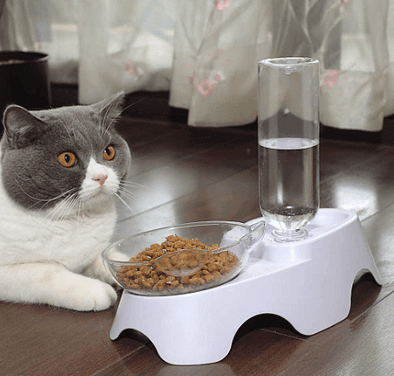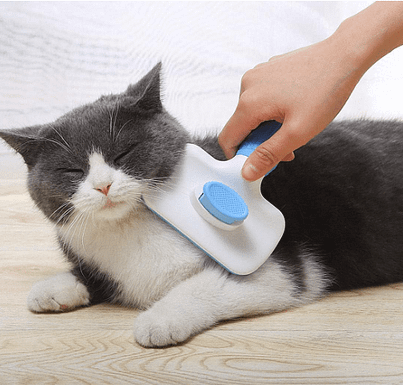Bringing your first cat home? How exciting!
After adopting a few cats, and taking care of a few lovely strays, I formed my own checklist for adopting a new cat.
This checklist contains the essentials, sorted by urgency level. Because some things can be borrowed and bought later, while others are essential for your cat from day one.
Table of content: “What do I need for a cat?”
- Find a vet
- Dry & wet food
- Food & water bowls
- Litter box and litter
- Cat carrier
- Cat toys
- Grooming tools
- Cat tree
- Scratching post
- Catnip
The new cat checklist
Find a vet
Before adopting a cat, make sure you find a good vet so that you can give them the best possible care from the beginning, ensuring their health and well-being.
To keep your cat healthy, you need regular check-ups, vaccinations, and preventative care.
Also, veterinarians can give you unbiased advice on cat behavior, socialization, training, and anything else you’re concerned about.
Dry & wet food
It’s important to provide your cat with a balanced and nutritious diet to support their overall health and well-being.
It’s OK not to know which cat food to buy because you can consult the vet and decide. Until then, our best advice is to buy a small portion of dry and wet food.
Things to consider when choosing cat food:
Every cat is unique, and individual dietary needs may vary. It’s always a good idea to consult with a veterinarian for personalized recommendations based on your cat’s specific needs and health condition.
1. Age-appropriate food
Cats have different nutritional needs at various life stages. Choose food specifically formulated for kittens if you’re adopting a young cat, or opt for adult cat food for older cats.
2. Wet or dry food?
Both wet and dry cat food have their benefits. Wet food helps keep cats hydrated, while dry food can help maintain dental health. A combination of both is often recommended, or you can consult your veterinarian to determine the most appropriate option for your cat.
3. High-quality ingredients
Look for cat food with high-quality protein sources (such as chicken, turkey, or fish) as the primary ingredient. Avoid products with excessive fillers, artificial additives, or by-products.
4. Complete and balanced nutrition
Ensure the cat food is labeled as “complete and balanced” or formulated to meet nutritional standards set by organizations like the Association of American Feed Control Officials (AAFCO).
5. Consider special dietary needs
If your cat has any specific dietary requirements or allergies, consult your veterinarian to find appropriate food options.
6. Transition gradually
If you know what kind of food your cat has been eating until adoption, it’s best to transition gradually to the new food. Just mix a small amount of the new food with the current food, increasing the ratio over several days until they’re solely eating the new food.
Food and water bowls
You can feed your cat in any ceramic (not lead-glazed) or stainless steel bowl you have in your kitchen. However, most people prefer special bowls for their pets.

Litter box and litter
One of the most notable benefits of adopting cats is that they can use a litter box!
Here are some things to consider when choosing a litter box and litter for your cat:
Select a litter box that is large enough (to comfortably turn around and dig).
Kittens may require smaller boxes initially but will eventually need larger ones as they grow. Additionally, choose a box with low sides or an entrance that is easy for your cat to access, especially if you have senior cats or kittens.
Litter box dilemma: Covered or uncovered?
Covered boxes provide privacy and contain the odor, but some cats may feel confined or uneasy using them. Uncovered boxes offer more visibility and ventilation but may result in more litter scatter. Our best tip here is to buy the cheapest litter box and decide later. Another option is to pick a covered litter box with separable parts, which allows you to ditch the cover in case your cat won’t corporate with it.
Litter types – buy the good one!
I don’t think I can stress this one enough – pick the finest litter you can find, even if it costs more money. Because if there’s something worth spending money on, this is it. I mean, when it comes to bad odors in the house, there are no compromises.
By considering these factors and monitoring your cat’s preferences, you can select a litter box and litter that will be well-suited to your cat’s needs and help promote good litter box habits:
- There are several litter options available, including clay, clumping, crystal, recycled paper, and natural alternatives like pine or wheat. Clumping litter is popular because it forms solid clumps that are easier to clean.
- Some litters have added odor-absorbing properties or are scented, but remember that strong fragrances may be off-putting to some cats. In my opinion, a high-quality litter can absorb scents without fragrances.
- Dust level: Cats, particularly those with respiratory sensitivities, may be bothered by dusty litter. Opt for low-dust or dust-free litter to minimize respiratory irritation.
And as cats have their own preferences, observe your cat’s reactions and behavior when introduced to a litter box and litter. Some cats may have aversions to certain textures or scents, so you may need to experiment with different options to find the one that works for you and your cat.
Cat carrier
It’s not safe to transport a cat without a carrier. And since from now on you’ll have to take your cat to the vet, it’s a wise investment. Make sure the carrier is the right size for your cat and has a secure latch to prevent escaping. Usually, when I carry my cats in a carrier, I put a cozy blanket inside to make them less stressed.
Cat toys
Cats need regular physical exercise and mental stimulation to maintain a healthy lifestyle. Cat toys provide an outlet for them to engage in active play, which helps burn off excess energy, prevent boredom, and promote overall well-being.
You can read more about the best cat toys for indoor toys here. And if you rather wait to see what your cat likes, that’s totally fine (although we do recommend buying at least a feather wand!).
Grooming tools
Grooming tools can help maintain your cat’s coat. While some cats may require more grooming than others, having a few essential pet care tools on hand is generally a good idea.
Here are some grooming tools you may find useful:
1. Brush or comb
A brush or comb suitable for your cat’s coat type can help remove loose hair, prevent matting, and keep their coat in good condition. Long-haired cats typically require more frequent brushing to prevent tangles and matting, while short-haired cats may benefit from regular grooming to minimize shedding.

2. Cat-friendly shampoo
It’s important to note that most cats are skilled self-groomers and generally do not require frequent bathing.
In some cases, you may need to bathe your cat to keep its coat clean, especially if it gets dirty or have specific skin conditions. Use a mild, cat-friendly shampoo specifically formulated for feline use.
3. Toothbrush and toothpaste
Dental hygiene is crucial for your cat’s overall health. Regular brushing with a cat-specific toothbrush and toothpaste can help prevent dental issues such as tartar buildup and gum disease. Introduce toothbrushing gradually and consult your veterinarian for guidance on proper dental care.
Cat tree
Some cats may require time to acclimate to grooming, so start with short sessions and gradually increase the duration as your cat becomes more comfortable.
If you’re unsure about the grooming needs of your specific cat breed or coat type, or if your cat requires professional grooming services, consult your veterinarian or a professional groomer for guidance and recommendations tailored to your cat’s individual needs.
Cats are curious creatures that need mental stimulation to prevent boredom and promote good behavior. A cat tree provides an enriching environment by offering different textures, heights, and hiding spots. It gives your cat opportunities to engage in natural behaviors, such as observing their surroundings, perching, and exploring.
Scratching post
Cats have a natural instinct to scratch, which helps them stretch their muscles, shed old claw sheaths, and mark their territory. Providing a scratching post gives them a designated place to satisfy their scratching needs, saving your furniture and other household items from damage.
Catnip
Catnip is a herb from the mint family, and it contains a compound called nepetalactone. When cats come into contact with catnip, they may exhibit behaviors such as rolling, rubbing, purring, and generally appearing more playful and relaxed.
Not all cats are affected by catnip, as sensitivity to it is an inherited trait, and some cats may not respond at all. Additionally, catnip effects typically last for a short period, usually around 10 to 15 minutes, after which the cat’s interest may diminish.
It’s important to note that while catnip is generally safe for cats and is not addictive or harmful to them, it’s recommended to use it in moderation.

